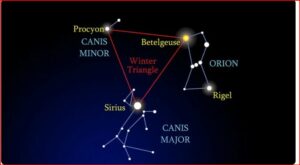Each year, skywatchers are treated to the dazzling spectacle of the Orionid meteor shower, which occurs when Earth passes through the debris trail of Halley’s Comet.
Lasting from October 2 to November 7, the meteor shower will peak on October 21-22, providing the best viewing opportunities. You don’t need to focus exclusively on the Orion constellation, as these meteor trails will be visible across the entire night sky.
How to Watch
The Orion constellation, where the meteors seem to originate, is easy to locate.
In the Northern Hemisphere, it appears in the southwestern sky, while viewers in the Southern Hemisphere will find it in the northwestern sky. But rest assured, you don’t need to aim your gaze directly at Orion to enjoy the show—meteors will streak across various parts of the sky.
The Winter Triangle

For those seeking guidance on finding the Orion constellation, NASA suggests looking for the Winter Triangle, a grouping of three prominent stars: Sirius, Procyon, and Betelgeuse. Sirius, the brightest star in the night sky, is a good starting point. From there, locate Procyon (the eighth-brightest star) and Betelgeuse (the tenth-brightest star), which is part of the Orion constellation. In the Northern Hemisphere, Betelgeuse appears as the upper-left star of Orion.

We are The People's Media. USA Herald covers everything from breaking news to investigative journalism. We also report on politics on the State and National levels.


